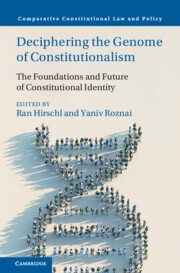190 results
7 - Cheap Speech and the Gordian Knot of Defamation Reform
- from Part II - Defamation and Privacy
-
-
- Book:
- Media and Society After Technological Disruption
- Published online:
- 16 May 2024
- Print publication:
- 23 May 2024, pp 66-84
-
- Chapter
-
- You have access
- Open access
- HTML
- Export citation
6 - Defamation and Privacy
- from Part II - Defamation and Privacy
-
-
- Book:
- Media and Society After Technological Disruption
- Published online:
- 16 May 2024
- Print publication:
- 23 May 2024, pp 63-65
-
- Chapter
-
- You have access
- Open access
- HTML
- Export citation
9 - Privacy Rights, Internet Mug Shots, and a Right to Be Forgotten
- from Part II - Defamation and Privacy
-
-
- Book:
- Media and Society After Technological Disruption
- Published online:
- 16 May 2024
- Print publication:
- 23 May 2024, pp 98-110
-
- Chapter
-
- You have access
- Open access
- HTML
- Export citation
8 - Defamation, Disinformation, and the Press Function
- from Part II - Defamation and Privacy
-
-
- Book:
- Media and Society After Technological Disruption
- Published online:
- 16 May 2024
- Print publication:
- 23 May 2024, pp 85-97
-
- Chapter
-
- You have access
- Open access
- HTML
- Export citation
10 - Brokered Abuse
- from Part II - Defamation and Privacy
-
-
- Book:
- Media and Society After Technological Disruption
- Published online:
- 16 May 2024
- Print publication:
- 23 May 2024, pp 111-126
-
- Chapter
-
- You have access
- Open access
- HTML
- Export citation
3 - Constitutional Identity as Discourse
- from Part I - Foundations, Theory, and Concepts
-
-
- Book:
- Deciphering the Genome of Constitutionalism
- Published online:
- 14 March 2024
- Print publication:
- 21 March 2024, pp 44-55
-
- Chapter
- Export citation

Deciphering the Genome of Constitutionalism
- The Foundations and Future of Constitutional Identity
-
- Published online:
- 14 March 2024
- Print publication:
- 21 March 2024
Assessing Impacts of “Anti-Equity” Legislation on Health Care and Public Health Services
-
- Journal:
- Journal of Law, Medicine & Ethics / Volume 52 / Issue 1 / Spring 2024
- Published online by Cambridge University Press:
- 31 May 2024, pp. 172-177
- Print publication:
- Spring 2024
-
- Article
-
- You have access
- Open access
- HTML
- Export citation
Public Health, Internal Borders, and the Ends of Federalism
-
- Journal:
- Canadian Journal of Law & Society / La Revue Canadienne Droit et Société / Volume 38 / Issue 3 / December 2023
- Published online by Cambridge University Press:
- 21 February 2024, pp. 410-428
-
- Article
-
- You have access
- Open access
- HTML
- Export citation
10 - Empire and the Political Economy of Fiduciary Law
- from Part II - The Recursive Development and Dynamic Consequences of Transnational Fiduciary Law
-
-
- Book:
- Transnational Fiduciary Law
- Published online:
- 22 November 2023
- Print publication:
- 08 February 2024, pp 237-260
-
- Chapter
-
- You have access
- Open access
- HTML
- Export citation
24 - Rights of out-of-State residents
- from Part 7 - Federalism
-
- Book:
- Australian Constitutional Law
- Published online:
- 14 December 2023
- Print publication:
- 04 January 2024, pp 695-713
-
- Chapter
- Export citation
6 - External affairs power
- from Part 2 - Legislative powers
-
- Book:
- Australian Constitutional Law
- Published online:
- 14 December 2023
- Print publication:
- 04 January 2024, pp 136-168
-
- Chapter
- Export citation
1 - Introduction to Australian constitutional law
- from Part 1 - Introduction
-
- Book:
- Australian Constitutional Law
- Published online:
- 14 December 2023
- Print publication:
- 04 January 2024, pp 3-38
-
- Chapter
- Export citation
12 - Implied freedom of political communication
- from Part 3 - Limitations on powers
-
- Book:
- Australian Constitutional Law
- Published online:
- 14 December 2023
- Print publication:
- 04 January 2024, pp 322-361
-
- Chapter
- Export citation
8 - Taxation power
- from Part 2 - Legislative powers
-
- Book:
- Australian Constitutional Law
- Published online:
- 14 December 2023
- Print publication:
- 04 January 2024, pp 201-234
-
- Chapter
- Export citation
9 - Constitutional alteration and the race power
- from Part 2 - Legislative powers
-
- Book:
- Australian Constitutional Law
- Published online:
- 14 December 2023
- Print publication:
- 04 January 2024, pp 235-256
-
- Chapter
- Export citation
19 - Institutional integrity of courts
- from Part 5 - The courts and judicial power
-
- Book:
- Australian Constitutional Law
- Published online:
- 14 December 2023
- Print publication:
- 04 January 2024, pp 537-574
-
- Chapter
- Export citation
4 - Trade and commerce power
- from Part 2 - Legislative powers
-
- Book:
- Australian Constitutional Law
- Published online:
- 14 December 2023
- Print publication:
- 04 January 2024, pp 96-113
-
- Chapter
- Export citation
14 - The Federal Parliament
- from Part 4 - The Federal Parliament
-
- Book:
- Australian Constitutional Law
- Published online:
- 14 December 2023
- Print publication:
- 04 January 2024, pp 397-430
-
- Chapter
- Export citation
10 - Acquisition of property on just terms
- from Part 3 - Limitations on powers
-
- Book:
- Australian Constitutional Law
- Published online:
- 14 December 2023
- Print publication:
- 04 January 2024, pp 259-296
-
- Chapter
- Export citation



